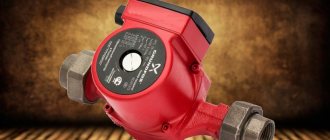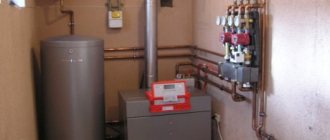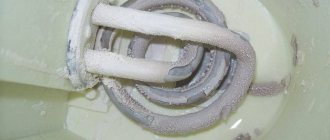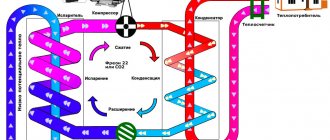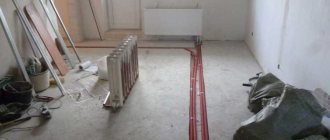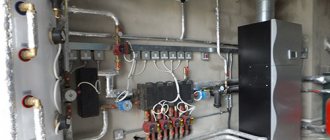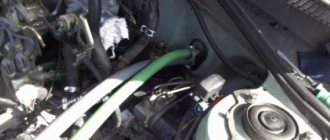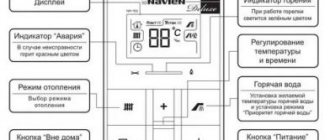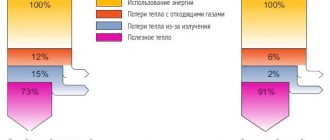Why is it necessary to flush the boiler?
Problems with the water supply and heating system may be associated with the heat exchanger of the gas boiler. Over time, various impurities contained in the water settle on the heat exchanger. Thus, a plaque appears that destroys the metal.
Under the influence of high temperatures, chemical reactions occur that reduce the quality of the heating system. The gas boiler and heat exchanger should be flushed periodically.
Flushing must be done once every 4 years if purified water is used as a heat carrier. If antifreeze is used, then this procedure must be done once every 2 years. Do not forget about regularly changing antifreeze.
How to choose a pump for flushing a heat exchanger?
Installations for washing heat exchangers differ:
- Pressure
- Productivity
- Tank size
- Availability of reverse
To select an installation, you need to understand the volume of heat exchangers you need to flush.
In practice, it is best to choose an installation with a tank volume 2-4 times less than the volume of the heat exchanger with automatic reverse. In this case, flushing will be the most comfortable and convenient, the performance and pressure of the pump will also be more optimal.
The volume of the heat exchanger can be found in the passport. If you can’t find the passport, don’t worry, a pump with a tank volume of 20-40 liters will be enough to flush heat exchangers for heating and hot water supply in most residential apartment buildings.
Advantages of a boiler flushing pump
The boiler flushing pump has the following advantages:
1. There is no contact of cleaning liquids with the external environment.
2. Interacts with caustic compounds.
3. Pressure can be controlled. The pressure decreases as a result of the production of gases.
4. You can connect the pump to the water supply system.
5. There is a reverse flow mode.
6. Before going down the drain, the cleaning solution is removed.
7. All connections of the booster with the drain outlets of the heating system are sealed.
Mechanical flushing of a gas boiler
Before starting flushing, you should disconnect all parts of the heating system. This is necessary to remove the contaminated part. This procedure can be performed using an automated or manual device, as well as a special installation for mechanical washing. To gain direct access to the contaminated part, it is necessary to disassemble the system.
After disassembling the heating system, it is necessary to remove deposits from the internal surface. This can be done using a brush or scraper. Heavily contaminated parts can be placed in an acid wash for a couple of hours. Thus, the part will be cleaned of even the smallest deposits.
This method is not cheap, as it requires complete disassembly of the heating system. But if you do not flush, then after a while you will have to replace the equipment or make major repairs due to scale and plaque. If you do the washing yourself, you should follow all safety regulations.
After you have washed with a chemical reagent, you need to run clean water several times to remove all the acidic residue. If this is not done, the heat exchanger may be destroyed, which means that the entire system will need to be repaired.
Some people use hydrodynamic flushing of gas boilers. Water jets with high pressure remove scale and plaque. This method is considered the most effective. This method is safe and there is no risk of system damage. Plaque is quickly removed from any type of gas boiler.
Before flushing, the entire heating system must be turned off. When installing a heating system, shut-off valves should be installed to simplify the procedure. You can use taps and valves on the supply and return pipes. It is necessary to connect hoses from the flushing device to them. But in some cases the hoses cannot be connected. Then it is necessary to carry out work on organizing flushing units. Such procedures will require additional costs.
Devices used
Pipeline cleaning can be done in different ways, and a specific unit is selected for each of them. The price of some devices can be quite high, since their efficiency is at the proper level. Some work can be done with your own hands using inexpensive tools.
Hydrodynamic installations
The main equipment is water jetting machines that supply liquid under high pressure. With their help, it is possible to eliminate deposits in pipelines with a diameter of 20 mm and above. The high efficiency of the method is achieved through the use of special nozzles.
Compact size water jet.
Hydrodynamic technology for removing scale and other contaminants is considered the most gentle, since when carrying out work inside the communication system, excessive pressure is not created. This operation is completely safe for installed elements.
Its features are discussed below:
- The advancement of the nozzle is ensured by jet thrust, which is created under the action of high-pressure water flows coming out of the holes in a special nozzle.
- This installation for flushing heating systems works most effectively when using high-performance nozzles. Their choice should be made depending on the nature of the blockage.
- For the most difficult jams, chain carousels and rotary tips are used. The resulting traffic jams in the communication network are successfully removed using punching nozzles.
This is what the pressure cleaning nozzle looks like.
Pneumohydraulic units
The main device is a compressor for flushing the heating system or a pump, which allows the accumulation of compressed air and a sudden release at a certain point in time. In this situation, purification is performed by creating a kinetic impulse in a liquid medium. The swirling water removes deposits from the surface of the pipeline.
The pneumohydraulic design has a special container designed for compressed air, which is usually pumped by a compressor. However, a special pump can also be used to flush the heating system. It is a cylinder equipped with a piston.
One side of the device is in contact with air, and the other with water.
A unit for pneumohydraulic flushing is demonstrated.
- At the very beginning, the device is connected to the heating elements through a switch and adapter hoses.
- After this, water is poured into the system, which enters directly into the cylinder of the main device, moving the piston to its original position.
- Next, the cylinder is charged until the required pressure is created.
- At the main stage, a shock wave is created using a piston, which makes it possible to clean the pipes.
Mechanical impact devices
In this case, flexible shafts with a drive are used, on one side of which metal brushes are placed. The tool that rotates the rod is usually a drill.
The following are instructions describing the procedure for carrying out the work.
The flexible shaft is presented in assembled form.
- At the initial stage, the system is prepared for cleaning activities. The coolant is completely drained, the pipe fittings are unscrewed in the right places.
- A structure is being assembled that will mechanically remove scale and other contaminants from pipelines. A metal brush of suitable size is attached to one end, and a drill to the other.
- Gradually, the flexible shaft is introduced into the interior of the conductive elements of the system. When the device rotates around its axis, scale will fall off the pipe walls.
Electrohydraulic devices
The operating principle of such installations is based on the fact that a coaxial cable is inserted into the liquid medium, which is connected to a high-voltage pulse device. The device creates repeated electrical discharges with a frequency of 1 to 10 Hz. Thanks to this, accumulated deposits are destroyed.
Example of an electrical installation.
Many models of cleaning equipment of this type are capable of cleaning pipelines whose diameter ranges from 10-100 mm. Additional devices may be supplied with the equipment.
Chemical flushing of a gas boiler
You can remove scale and deposits from the heat exchanger and heating boiler using chemical compounds. Acid is often used for this, which perfectly removes carbonate scale. This scale is formed as a result of the combination of calcium and magnesium salts and ferric iron, which settles on the surface of the heat exchanger.
You can do chemical washing yourself. In order to perform flushing in this way, you do not need to disassemble the heating system. Therefore, this method will be cheaper than the mechanical one.
For chemical washing you will need special equipment (booster for washing the heat exchanger) and a chemical reagent. The booster consists of the following elements: pump, heating element and tank. When flushing with a booster, a warm solution is first introduced into the heat exchange system.
With the help of such a device, the cleaning reagent circulates and the waste liquid is removed. The booster can be used for chemical flushing of any gas boiler. The booster differs favorably from other installations for washing boilers in that there is no need to use a heating element to heat the cleaning liquid. In the booster, a heat exchanger heats the liquid.
But despite the advantages of this heating method, it is recommended to use a heating element for safety. Thanks to this element, the solution is heated to a certain temperature and acts on different parts of the heat exchanger with equal efficiency.
Acid washing is used to remove ferric scale or carbonate scale. The main reagents that make up the solution are hydrochloric or sulfuric acid, sometimes nitric or phosphoric acid is used. Depending on the amount of scale and type of contamination, as well as on the material from which the boiler and heat exchanger are made, the reagent is selected.
You can flush a gas double-circuit boiler yourself in two stages. To do this, at stage 1, an active reagent is used, which has acidic properties. A powerful flow of solution is created using a reversible pump. Thus, the layer of deposits that would be affected by the acid is eroded.
This process usually takes 2.5-6 hours. It all depends on the amount of contamination on the surface of the heating gas boiler. After dissolving scale and deposits, remove the active solution and fill the heat exchanger with the solution, which removes the acid residue. A heat exchanger made of cast iron should not be washed on its own due to the possible reverse effect.
Operating principle of boiler washing units
Special reagents are used to clean closed systems and heating units. A solution is pumped into pipelines and boilers using a pump to flush the heat exchanger, where, under the influence of acid, deposits are softened and scale, plaque, and rust are removed. Biological growths can be removed using alkaline washing. It is used only in some cases.
The cleaning process takes place using a hydrochemical method. Thanks to the chemical pump, the reagent solution circulates inside a closed loop. Without compromising the integrity of the surface of the heating system, connecting units, sealing gaskets and heat exchanger, deposits are dissolved and then washed away. The solution moves under pressure, and stagnant areas do not form.
The process of washing the heat exchanger is simple, but all safety rules must be followed, since the chemical compounds are harmful to humans. Therefore, when flushing a gas boiler, it is necessary to wear protective clothing, gloves and goggles. In addition, the room must be ventilated. The gas boiler should be disconnected from gas.
The heat exchanger or system must first be freed of liquid. Next, connect the washing unit with a pump, taking into account all the points in the manufacturer’s instructions. Afterwards you need to prepare the solution. To do this, you need to dilute the liquid in water as written on the label. Heat the solution to a temperature of 30-40 degrees. Deposits will be better removed with warm liquid. The solution must be poured into the container and the pump must be turned on. The washing unit must be switched to circulation mode.
It is necessary to flush the device until all contaminants are dissolved and removed from the system. You can check the quality of cleaning using a special test. The equipment comes with a reusable test kit. On average, it takes 2-6 hours to remove dirt. The time depends on the following factors:
1. Degree of pollution.
2. Heat exchanger size.
3. Pump performance and cleaning plant power.
After washing, you need to rinse the heat exchanger with a solution that will remove all acid residue.
After this procedure, the surfaces should be treated. This treatment is called passivation. For this, a reagent is used that forms a durable thin oxide layer on the metal walls. Thanks to this layer, the material resists corrosion. If the equipment is made of aluminum, then this method cannot be used.
An important step in flushing boilers, boilers, radiators and heat exchangers is the removal of reagents used in their cleaning. Under no circumstances should the solution be washed down the drain without treatment. A special liquid is added to the spent reagent to bring the acidic environment to normal pH values. You can also use crystalline powder that is poorly soluble in water. Sometimes you can replace the neutralizer with a large volume of tap water, which is mixed with the reagent before draining. After this, the liquid can be directly drained into the sewer.
In order to flush gas boilers with low power, it is enough to use equipment with low power. If it is necessary to flush branched networks, then a high-performance flushing unit should be used. Such equipment is considered professional, and, therefore, the cost is rather high.
Many specialized companies offer to rent a washing unit. But in order to carry out high-quality washing, it is better to invite specialists who have experience in carrying out such work.
Pumping units for flushing heating systems
Heating flushing equipment creates increased pressure in the pipeline. The system is cleaned through forced circulation of injected reagents. Chemicals, moving through closed pipes, remove large amounts of salts, deposits and contaminants.
You can determine that the heating system is dirty and requires flushing by the following signs:
- Reduced heat transfer;
- Poor heating of individual radiators or heating circuit;
- Clogged dirt filter;
- Frequent shutdown of the boiler;
- Increased fuel consumption.
A powerful flushing pump is an indispensable installation used in complex branched heating circuits. The equipment is used in residential apartment buildings, as well as in private households, commercial and industrial buildings. With regular use of the pumping unit and special reagents, the risk of blockages in the pipeline is reduced to zero.
Disadvantages of chemical flushing of boiler installations
Chemical washing is the most convenient and easiest. But it has some disadvantages:
1. High cost.
2. A long process may ruin the surface of the metal.
3. With a short period of exposure, undissolved growths may remain.
But such shortcomings can be avoided by using high-quality reagents, as well as by correctly performing the technology for cleaning the heating boiler and heat exchanger. In addition, it is necessary to pay attention to the condition and age of the heating system. In some cases, it will be better to replace the system with a new one rather than clean out the old one. If the heat exchanger is faulty, it can lead to breakdown of the gas boiler. Therefore, it is necessary to periodically check the operation of this element of the system. For example, regularly wash equipment.
Each reagent is supplied with instructions in which you can find out what metal and system the reagent is intended for.
The disadvantage of chemical washing cannot be attributed to the use of the wrong solution due to carelessness. Manufacturers produce reagents for technical systems that are environmentally friendly and used for cleaning food heating equipment. Some compositions are indispensable in critical situations, while others dissolve only lime deposits.
In addition to using reagents, heating boilers can be cleaned mechanically. But this will require disassembling the equipment at least partially, which is not always possible for various reasons. This method is not suitable at all for radiators and metal pipes. In addition, mechanical stress often leads to damage to the protective layer on metal walls, which can lead to rapid corrosion.
It is not recommended to use hydrochloric acid for washing, which is an aggressive substance. Under the influence of such a solution, galvanized surfaces and connecting elements become unusable. After flushing the heat exchanger and heating system, it is necessary to fill the pipes and equipment with high-quality water or antifreeze immediately after cleaning and removing acid residues. This is necessary to prevent any problems.
